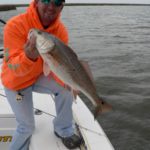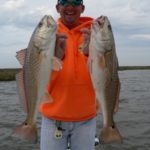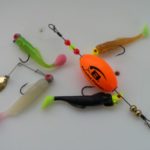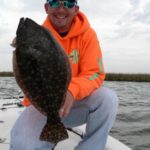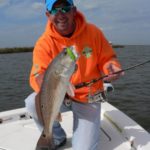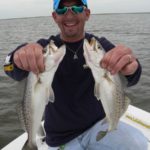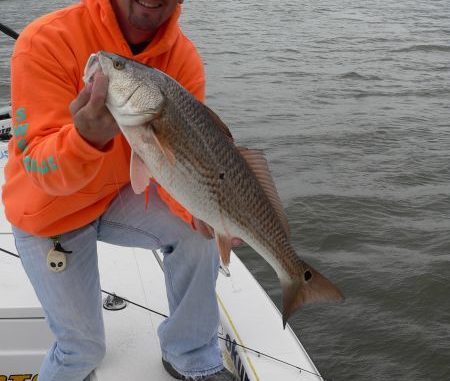
It’s not an Olympic sport, but maybe it ought to be!
The early morning sky was grey and overcast, and a cold chill greeted us as we stepped out of the truck at the Sweetwater Marina in Delacroix. My son-in-law, Shane Ansardi, and I were meeting Capt. Chris Pike (504-427-4973) for some redfish angling in the ponds, a trip we’d planned and postponed several times already due to contrary conditions.
Today was supposed to be better. The forecast was for brighter skies, lighter winds and higher water — actually the best forecast in weeks, so we came to take advantage of it. Unfortunately, the weather didn’t get the memo that winter was over because it showed up with a drop in the thermometer and a wet bite in the air that made it feel even colder than it was.
Marina owner Jack Payne pointed across the street to where Pike had his 24-foot Skeeter bay boat loaded up and already idling at the dock. Since the weatherman said the temperature would be in the warm and sunny 70’s, Shane came wearing shorts! I felt the cold and wet, and grabbed my heavier jacket for the boat ride (always better to bring more clothes than you need); we stowed our gear aboard the big Skeeter, and Pike pointed the bow down Bayou Gentilly.
“We’re going to stay with our game plan,” Pike said over the drone of the 250-horse Yamaha outboard pushing us down the bayou. “Apparently, the front that wasn’t supposed to reach us, did, and the water is a bit lower than I’d hoped, and the wind is blowing from the wrong direction making it colder than we expected, but we can still fish the deeper ponds, and I’m confident we’ll find some clean water and some fish.”
Buoyed by his confidence, I buried as much of my face as I could in my jacket against the cold wind and was thankful that our ride would be short, and that I wasn’t the one wearing the shorts!
The plan
Every fishing trip starts with some kind of game plan — just as a football coach has an offensive and defensive strategy for each opponent he faces. He has to consider the strengths and weaknesses of each team and plan a strategy around it. And in case the original plan falters, he needs a good back-up plan, a Plan B.
Fishing is very similar. You consider the conditions — water, wind, tide, etc. — and you make a plan accordingly. Our plan was to puddle jump for redfish. Pike has a few prime areas, all pretty close to the dock, where redfish roam and even speckled trout like to come out and play this time of year. All of the areas are easily reachable in a small boat and actually more easily fished in a small boat because the water tends to be shallow.
Our original plan was to take advantage of the higher water and get up into the ponds. We hoped the water would be calm and clear enough to do some sight-fishing for the redfish that not only frequent the marsh ponds this month, they actually favor them, making these spots prime areas to toss soft plastics tight-lined, gold spoons, beetle-spins and even topwater baits.
Unfortunately, the winds and water conditions would make sight-casting impossible, and the lower water might prevent us from getting into some of the shallower areas, but Pike was prepared with a back-up, Plan B. We’d fish the deeper ponds, we’d blind cast rather than sight cast, and if all else failed, we’d resort to Plan C.
Puddle jumping
I know how it is, when April comes around and May is knocking on the door, and visions of big, hungry trout tearing up your bait on the outside waters dance through your head — you want to point your bow to the outside bays! You hope they’ll be there early this year, and you’re almost drooling with anticipation of that big trout bite. But you might want to hold your horses just a little while longer, and consider some puddle jumping this month. Pike says there will be plenty of action at these three of his favorite areas deep in the inside waters in April, and while redfish will be the chief draw, trout will show up in the mix.
The Lake John ponds
“Just to the north and west of Lake John are a series of big ponds, all averaging about 2½ feet deep or less, and connected by small deeper canals between the ponds,” said Pike. “Usually the crabbers have a line of crab traps in these canals because they tend to have a good population of them in there, and it’s the crabs that make the ponds so attractive to the redfish.
“Crabs are the primary prey of redfish right now, so whenever the water is up and they can get in the ponds, they’ll be in there.
“Also, these ponds tend to stay clean, so it’s a good place to sight-cast. I prefer to fish the windblown banks because the bait will be windswept toward that shoreline. So I’ll troll as far from the windy shoreline as I can cast, and look for signs of fish. If you get too close to the bank, you’ll spook the fish in that clear water. If you see the tell-tale “V,” you’ll want to cast about 4 feet in front with a soft plastic on a ¼-ounce jighead, or a beetle-spin or spoon. I like Bomber Mud Minnows in either black/chartreuse or root beer/chartreuse when fishing in clear water. If the water isn’t so clear, I’ll switch to something with more color, like electric chicken.
“On windy days, and when the water is lower like today, we’ll focus on the bigger ponds, which tend to be deeper, and we’ll fish a good ways off the shoreline and even more in the middle of the ponds where there are some marsh islands or grass.”
Pike says it’s important to know the depth of the ponds before you run in them, so use caution and some good common sense, and avoid them altogether in low-water conditions.
“On days when you can’t sight-cast, troll the shorelines and work the main points jutting into the ponds very thoroughly, and also what I call the secondary points, those not as prominent,” said Pike. “And a soft-plastic bait suspended 12 to 18 inches under a cork is a great way to work those points, especially on windy days. But you’ll have to try with and without a cork, especially the popping corks. I’ve actually found that a noisy popping cork can sometimes be counter-productive under calm, clear-water conditions.”
But Pike says a popping cork is definitely the way to go on windy days.
The ponds north of Bay Shallow
“These ponds are great for fishing on windy days, days with north winds, lower water and falling tides,” said Pike. “There are several deeper canals throughout this section of marsh, and you’ll want to fish any of the cuts, ditches and drains.
“Fish the mouths of ponds with either soft plastics or shrimp under a cork, and just troll until you find some fish and then stick the Power Pole. Give it 10 or 15 minutes and if nothing else bites, move. Resume drifting and trolling, and repeat the process. If you catch four or five fish in a spot and the action stops, wait at least 10 minutes to see if it starts up again. I find the fish will bite in cycles like that. They’re swimming around the area and will sweep past you again every 10 or 15 minutes.”
The ponds west of Lake Batola
“You need a good high tide to get into these ponds, and when the conditions are right you’ll usually find crystal-clear water and plentiful redfish,” Pike said. “This is a great area for sight-casting, and for simply trolling along the banks and casting black/chartreuse or root beer/chartreuse Mud minnows, beetle-spins or spoons.
“I like to fish the bigger, deeper ponds, and there should be some grass in the ponds, and you can fish along the grasslines for reds just like you do for bass. By the summer, the grass will be too thick to fish in here, but right now it’s prime. Remember to stay as far off the bank as you can reach in a long cast because the fish are easily spooked in the clear water.”
What to look for in a pond
Pike says he looks for three main things when deciding which ponds to fish and which ones to ignore.
1) “I want to fish a falling tide. It doesn’t have to have a big tidal range, but I do prefer it falling,” he said. “Keep in mind, reds’ primary food source this month is crab, and they’ll be hunting them along the shorelines. I’ll mostly concentrate at drains or any outlet into the ponds.
2) “Look for crab activity, or any baitfish activity. I’ll look for any bait movement around points and cuts and coves, and if I find bait, I’ll spend 10 minutes or so trying that area.
3) “You want to fish ponds with grass. The reds will be along that grassline hunting bait, so troll and work along it with your soft plastics, beetle-spins or spoons.”
By that time, we had worked over several good ponds, slinging Bomber Mud Minnows on a ¼-ounce chartreuse jig head, which Pike prefers when fishing redfish, and we had quite a few reds in the box to show for it.
“I find that redfish will hit a painted jig better than an unpainted one, especially in cloudy water, and I find the chartreuse color seems to produce best,” he said. “But when I’m fishing for speckled trout, I prefer an unpainted jig head, so I’ll cut the painted one off and fish a plain one.”
We’d been fishing under far less than ideal conditions, with cold, stiff winds and minimum water clarity, and the conditions only worsened as the morning wore on. Pike decided to pull out all the stops and resort to Plan C, which he reserves for just this kind of difficult condition.
What is Plan C?
He reached into the bottom of the ice chest and pulled out a bag of dead shrimp, which we strung on a hook tied about 12 to 18 inches under a cork. He stuck the Power Pole near a prominent point in the marsh, and we all cast out and waited.
Pike says he doesn’t particularly like to use Plan C simply because it requires less skill, but as all redfish anglers know, it is certainly effective. Within a very short time we were all slinging redfish over the gunnel and returned to the dock only a couple fish shy of our three-man limits.
We’d also managed to put a dozen nice trout in the boat by drifting out in the middle, and a hefty flounder fell prey to Pike’s Mud Minnow at one of the points over a hard bottom. At no time were we more than 15 minutes or so from the dock, so puddle jumping in Delacroix is certainly a great option for anglers in April.
Capt. Chris Pike can be reached at (504) 427-4973.
Destination Information
HOW TO GET THERE — Delacroix is about a 45 minute drive from New Orleans. Take I-10 East from downtown to the I-510 (Paris Road), exit and go south to Chalmette. Turn left on Highway 39, and follow it for about 10 miles. After you cross over the Violet overpass, turn left at the blinking light onto the four-lane highway, and follow it for approximately 9 miles until you come to a four-way stop. Go straight (Highway 300) after the stop to Delacroix.
MARINAS — There are several launch sites providing access to Delacroix-area waters.
Serigne’s has a backdown, fuel, ice, accessories and live and dead bait.
Sweetwater Marina has a backdown, fuel, live and dead bait, ice and accessories.
Reggio Marina (just a couple miles past the four-way stop and a few miles before Delacroix Island) has a backdown ramp.
MAPS — Standard Aerial Photo Map No. 302; NevaLost Map No. 8.
